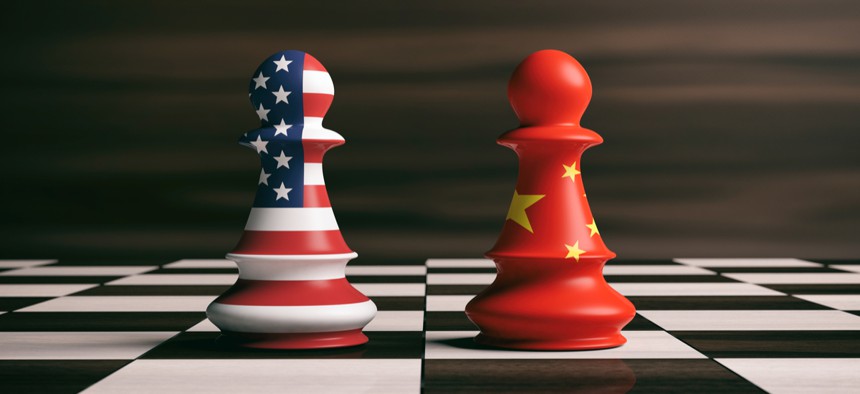Don’t Call It an ‘Arms Race’: U.S.-China AI Competition Is Not Winner-Takes-All

Faheem Rahput/Shutterstock.com
The most common framing of the two countries’ artificial-intelligence development is dangerous.
The United States and China are undoubtedly in an era of great-power competition; both countries, among other actions, are consolidating national resources and investing in science, technology, and industrial productivity to boost state power. Many cutting-edge technologies are involved in this international rivalry, including 5G telecommunications, quantum computing, and artificial intelligence. Yet with respect to AI, the dialogue around U.S.-China competition has been rather consistently framed as an “arms race.” Michael Kratsios, President Trump’s deputy assistant for technology policy, even used this framing in a recent op-ed about the administration’s executive order on AI development.
The problem is: this winner-takes-all “arms race” framing is wrong—and it’s dangerous for American policymaking. To better design policies that bolster American AI development and confront China’s technological rise, policymakers must reframe their approach to this technological competition.
To start with, the way some analysts—spanning government, industry, academia, journalism, think tanks—discuss an AI “arms race” makes it sound as if the development of these technologies is siloed within the United States and in China. But there are great interdependencies and interconnections between AI development in the two countries; artificial intelligence is not developed on isolated tracks.
Chinese companies have invested billions of dollars in American AI firms, and American companies rely heavily on Chinese manufacturing technologies, which will be increasingly important for U.S. entities as AI is deployed more and more in the likes of robots and drones. Knowledge, too, flows across borders: Kai-Fu Lee, former head of Google’s operations in China, runs an AI training institution that uses expertise from North American computer scientists. Baidu, the Chinese search company, belongs to the U.S.-based Partnership for AI, a consortium focused on safe AI development. Researchers between China and the United States may share data, co-author papers, and generally work on similar problems. The list goes on.
Further, any zero-sum implications that result from this “arms race” view are also incorrect. There are certainly security risks that may result from U.S.-China tech interdependencies and interconnections, from intellectual property theft to Beijing’s objectives around poaching American AI talent. However, AI applications in areas like healthcare—for instance, systems that improve cancer prediction—could greatly improve medicinal outcomes and quality of life in both nations. The winner-take-all view of an “AI arms race” once again falls short.
The Trump administration’s proposed sweeping export controls on AI are just one indication of this framing’s real-world, problematic effects. Broad restrictions that adopt a winner-takes-all view of AI competition may in fact hurt tech development in the United States, for universities and businesses alike, by cutting off vital sources of funding, knowledge, and other resources. MIT’s R. David Edelman notes that trying to distinguish in export control policies between what is military versus civilian use of AI “may be impossible,” and thus, OpenAI’s Jack Clark says, “the chance of making an error is quite large.”
In short, a growing emphasis on a winner-takes-all “arms race” threatens to push the two countries’ tech sectors apart, potentially damaging AI development in ways we can’t foresee. This needs to be addressed. For one, we as a collective national security establishment (as well as those beyond it) need to stop calling U.S.-China AI competition an AI “arms race.”
But more substantively, there are a few steps policymakers should take. Rather than diminishing the “openness that is so integral to American innovation,” federal policymakers should instead focus on the ways in which China is actually aided in a winner-takes-all fashion by American ideas and resources.
In particular, the United States federal government needs to take stronger action to reduce Chinese thefts of American intellectual property. Despite a 2015 Obama-Xi agreement to curb this practice—a pact that at least initially seemed to reduce the volume of attacks—Chinese thefts of American IP have ramped back up. Indeed, a March 2018 report from the Office of the U.S. Trade Representative reached found that “Beijing’s cyber espionage against U.S. companies persists and continues to evolve.” In a fashion that certainly implicates artificial intelligence (techniques, training data, etc.), “Chinese state-sponsored cyber operators continue to support Beijing’s strategic development goals, including its S&T advancement, military modernization, and economic development.”
Strengthening incentives for the FBI to investigate cybercrime cases, increasing interagency cooperation, and bolstering diplomatic cyber capacity could help the U.S. to name-and-shame Chinese hackers stealing American intellectual property. And like Adam Segal and Lorand Laskai have suggested, the U.S. could “move beyond indictments” to establish targeted sanctions on Chinese entities caught in this practice.
The White House also needs to design a cohesive, national AI strategy that not only outlines the government’s long-term vision for artificial intelligence—which should also include strong democratic norms around AI’s use—but identifies the AI applications most valuable to economic growth and military enhancement. Again, rather than taking a simplistic, winner-takes-all view of U.S.-China AI competition in which any and all collaboration is to be stopped, the better path is to maximize AI’s potential for the United States and humanity in general—while developing nuanced policies to target sources of disproportionate Chinese advantage.
Justin Sherman is a cybersecurity policy fellow at New America, a fellow at the Duke Center on Law & Technology, and a student at Duke University.





